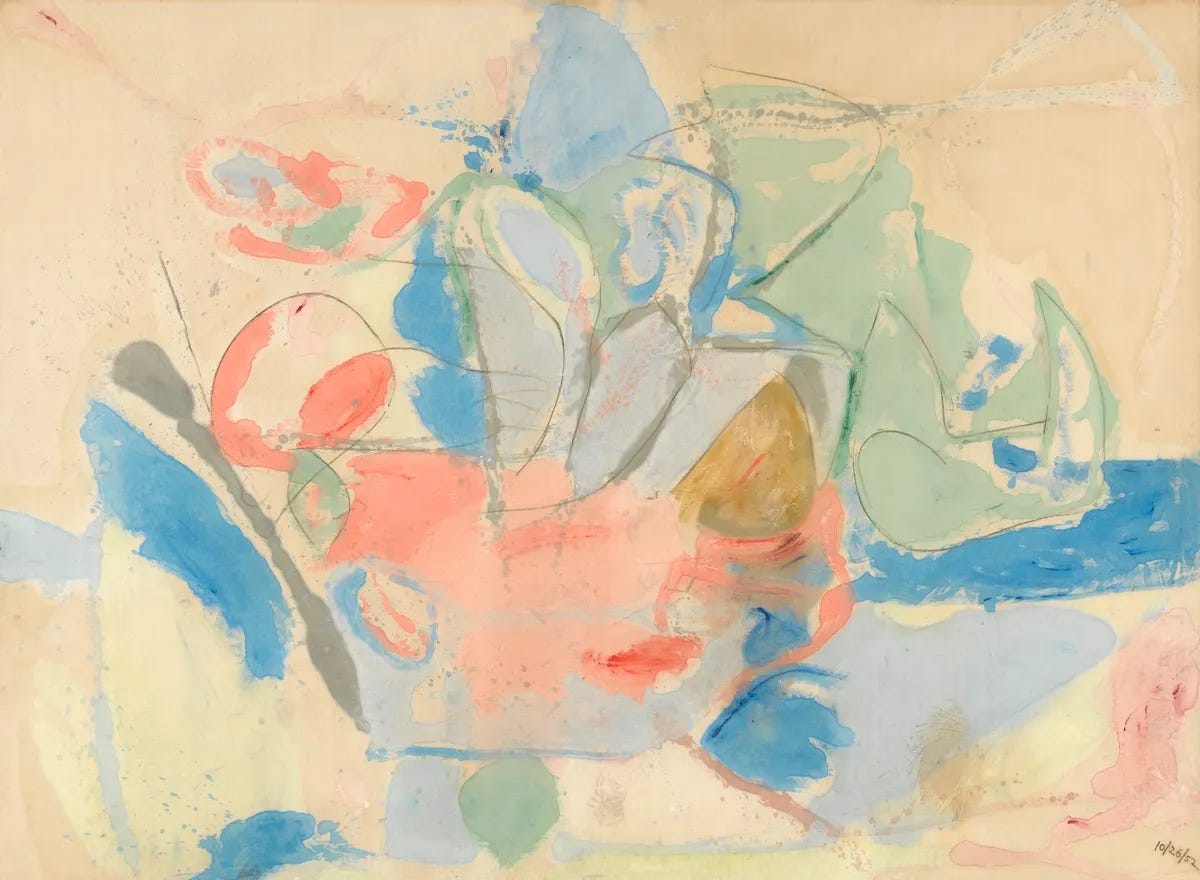Helen Frankenthaler, Mountains and Sea, 1952.
Last week, the Wall Street Journal put out an article about Helen Frankenthaler, which I read with great interest. I have been on a bit of a Frankenthaler kick ever since I read her recent biography, Fierce Poise, by Alexander Nemerov. The biography is a beautifully composed portrait of the artist, clearly by a fan of her and her work (he frequently refers to her as Helen) that puts forth a glittering, atmospheric vignette in the same vein as Hemingway’s A Moveable Feast or a Sofia Coppola film. I already admired Frankenthaler’s work, but the book heightened my appreciation of her. This new WSJ article took me by surprise, however.
The crux of the article is that Frankenthaler has fallen out of favor. For example, her work has been realizing relatively small sums of money at auction compared to her counterparts such as Joan Mitchell. Even though her estate is represented by Gagosian, the claim is that she is not faring well in the marketplace. Apparently she is unknown in Asia, where many heavy-hitter collectors now hail from. It is also mentioned that her opposition to Robert Maplethorpe and Andres Serrano during her lifetime could be problematic. Mostly, though, the article chalks her fall up to her estate’s mismanagement. There’s a lot of familial infighting it seems. Some family members have wondered if others are using Frankenthaler’s legacy to bolster their own careers. Her nephew is angry with her stepdaughter, Lise Motherwell, for organizing an exhibition in Provincetown, MA where Frankenthaler and her former husband, Robert Motherwell, used to spend their summers. The nephew, who initially supported the exhibition, later decided the venue was too small potatoes, noting that Frankenthaler had expressed her wishes for exhibitions in major American cities. It does sound messy, but it sounds more like a case for Chouette.
When I was in high school first learning art history, I already knew a lot about Helen Frankenthaler. I can’t remember when I would have first heard of her, but she was almost as big as Jackson Pollock it seemed. (Maybe this was the influence of my Modernist grandmother.) One thing I specifically remember learning is that she invented the soak-stain technique for painting. Morris Louis only trailed behind her, having learned of the technique after a visit to her studio with Kenneth Noland. For this reason, I felt she was the biggest AbEx woman painter—so much so that I didn’t think of her has a woman painter the way I did Lee Krasner, Joan Mitchell or Grace Hartigan. In fact, I hardly knew anything about Mitchell or Hartigan until the Women of Abstraction Expressionism exhibition came through the Mint Museum in 2016. So what’s all this fuss about ‘no one cares about Helen Frankenthaler?’
Frankenthaler died in 2011, so I would have done most of my formative learning about her prior to that time. In college, where we admittedly didn’t talk much about her beyond survey courses, she would have already been dead. The WSJ article notes that her death didn’t elevate her career to new heights like most famous artists who die. They cite the fact that she was far more prolific than many of her peers and it’s also where they mentioned she wasn’t big on Maplethorpe or Serrano (he did Piss Christ, if you’re unfamiliar.) Ok, so she wasn’t cutting edge later in life. I don’t buy that as the reason she’s not huge right now. I don’t buy the prolific argument, either. Gagosian shows her—I don’t think she’s washed up. So what is it? The article throws one more theory out other than family drama—critical opinion. After she died, critics began knocking her as a decorative painter more than a serious artist. And that, my friends, might be it.
I don’t want to give critics too much credit or power, so I wouldn’t definitively say that their assessment of Frankenthaler has closed the book on her, but I would say that the “decorative” critique is another sign of the times that Chouette is aiming to challenge. Are her paintings decorative or are they beautiful? I’ll ask this again and again and again…why are we so afraid of beauty right now? (I’m actively in the process of trying to figure that out.) It seems like every time the art world has exhausted discussion of something, they slap decorative, sweet or pretty on it and throw it in the garbage. I wonder what art history students are learning about Frankenthaler now. That she’s a washed up hack who gets low auction numbers or that she invented the soak-stain technique? You tell me which one is more accurate and in better service to feminist discourse.





